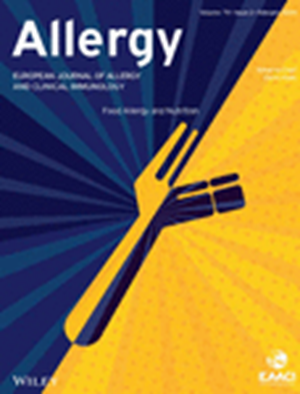重度哮喘对生物制剂反应的预测因素:一项系统综述和荟萃分析。
IF 12
1区 医学
Q1 ALLERGY
引用次数: 0
摘要
生物制剂对严重哮喘是有效的,但并不是所有患者都受益。迫切需要了解哪种生物制剂对哪种患者最有效。从1990年到2024年,我们系统地检索了4个文献数据库和2个试验注册库中治疗严重哮喘的生物制剂(omalizumab除外)反应的预测因子。两名审稿人筛选记录,提取数据,并使用改进的CASP检查表评估偏倚风险。对数据进行叙述性综合,并使用改进的GRADE框架评估证据的确定性。使用随机效应模型对可比研究进行meta分析。从5853份记录中,确定了21项研究调查抗il5 / 5r α, 4Rα和抗tslp反应的预测因素。我们发现主要是“中等”到“高”质量的证据表明,血液嗜酸性粒细胞计数升高(≥300个细胞/μL), FeNO水平(> - 40 ppb), OCS剂量不足或低剂量(< 10 mg/天),以及更好的哮喘控制预示着生物反应。其他特征的预测价值的证据有限,而且大多是“低”质量。证据降级的主要原因是异质性反应定义和不精确。未发现针对非t2通路的儿科人群或生物制剂的数据。在传统的炎症和临床变量之外,对普遍适用的严重哮喘生物反应预测指标的需求尚未得到满足。本文章由计算机程序翻译,如有差异,请以英文原文为准。
Predictors of Response to Biologics for Severe Asthma: A Systematic Review and Meta-Analysis.
Biologics are effective for severe asthma, but not all patients benefit equally. There is an urgent need to understand which biologic works best for which patient. We systematically searched for predictors of response to biologics (except omalizumab) for severe asthma in four bibliographic databases and two trial registries from 1990 to 2024. Two reviewers screened records, extracted data, and assessed risk of bias using a modified CASP checklist. Data were synthesized narratively, and certainty of evidence assessed using the modified GRADE framework. Comparable studies were meta-analyzed using a random-effects model. From 5853 records, 21 studies were identified investigating predictors of anti-IL5/5Rα, 4Rα, and anti-TSLP response. We found predominantly 'moderate' to 'high' quality evidence that raised blood eosinophil counts (≥ 300 cells/μL), FeNO levels (> 40 ppb), lack of or low OCS dose (< 10 mg/day), and better asthma control predict biologic response. Evidence for the predictive value of other characteristics was limited and mostly 'low' quality. Key reasons for downgrading the evidence were heterogeneous response definitions and imprecision. No data were identified for the pediatric population or biologics targeting the non-T2 pathway. Outside of traditional inflammatory and clinical variables, there is an unmet need for universally applicable predictors of biologic response for severe asthma.
求助全文
通过发布文献求助,成功后即可免费获取论文全文。
去求助
来源期刊

Allergy
医学-过敏
CiteScore
26.10
自引率
9.70%
发文量
393
审稿时长
2 months
期刊介绍:
Allergy is an international and multidisciplinary journal that aims to advance, impact, and communicate all aspects of the discipline of Allergy/Immunology. It publishes original articles, reviews, position papers, guidelines, editorials, news and commentaries, letters to the editors, and correspondences. The journal accepts articles based on their scientific merit and quality.
Allergy seeks to maintain contact between basic and clinical Allergy/Immunology and encourages contributions from contributors and readers from all countries. In addition to its publication, Allergy also provides abstracting and indexing information. Some of the databases that include Allergy abstracts are Abstracts on Hygiene & Communicable Disease, Academic Search Alumni Edition, AgBiotech News & Information, AGRICOLA Database, Biological Abstracts, PubMed Dietary Supplement Subset, and Global Health, among others.
 求助内容:
求助内容: 应助结果提醒方式:
应助结果提醒方式:


